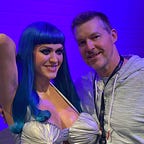CrossFit’s Superpower(s)
In my previous articles I have touched on how CrossFit has been disruptive to the fitness industry by innovating on product architecture. In this post I’d like to highlight a key aspect of their product architecture, their media strategy, and how it is arguably better than any other professional sport.
Some quick context:
- Cross hasn’t been around very long. The first CrossFit Games was in 2007, and it was mostly a “backyard bbq” with some workouts thrown in for good measure at Dave Castro’s ranch in Aromas, CA.
- The professional sports landscape is very crowded. You have the NFL and College Football occupying the late-summer into winter (now early February). You have the MLB starting in Spring and going into the fall. You have the NBA starting in late fall and going into the start of the summer. Golf seems to last forever and tennis gets what it can get.
- The CrossFit Games are currently held in Madison, WI, but they have looked at sites such as the Cotton Bowl in Dallas, TX, and even hinted at a European location. So the scale and potential of the Games is growing.
So what is CrossFit doing right? How does a startup professional sport get eyeballs and airtime in this environment?
From a YouTube search, both the CrossFit and CrossFit Games channels have videos from 2010 forward. Those videos encompass everything from examples of how to do the workouts, instructions on how to do a specific exercise like a squat or clean and jerk, footage of Games athletes working out and how they eat and recover, impromptu community gatherings — just about anything that has happened with CrossFit and the CrossFit Games has been documented on video, memorialized on YouTube.
And if you watch those early videos, it’s clear they were figuring it out. The video quality gets better and better over time. Fast forward to 2022, and the most recent documentary about the 2021 CrossFit Games is easily one of the best produced, visually stunning, and compelling video of all of them. Its that good.
Side Note: There is some debate about the quality of the color commentary related to the CrossFit Games. Because the sport is still nascent (compared to most other pro sports), they don’t have the depth of talent in the color commentary department. But it’s coming.
So why does this matter? CrossFit is the only professional sport which humanizes their athletes this way. None of the American big 4 sports (NFL, MLB, NBA, PGA) get up close and personal with their athletes. All you get from those sports is polished images of lots of standard lines e.g. “gotta take it one game at a time”.
This intimacy with CrossFit, documented and created thru video is a key part of the product that is experienced by customers. It creates personal connection to multiple aspects of the product (the CrossFit methodology, and the sport side of it). Building on this humanization, it is not uncommon for the Games athletes to travel and “drop-in” and workout with normal people at the CrossFit box in the place their are visiting. Do these CrossFit athletes do this to also build social followers, and hence opening up other avenues of income? Sure. But hopefully, they also realize they are part of a product that is radically different and if they embrace that, it will ultimately get them what they are working for — to be well-paid, and human professional athletes. Not distant objects that perpetuate the wall between customers and them.
The other big sports don’t create a documentary after the season that highlights the ups and downs of the competitions, the challenges that individuals faced during the offseason, and/or the travails that athletes had going thru the season. Nor do they capture the raw emotions that the athletes had after a game. CrossFit does this and releases it on streaming platforms including Apple TV and Amazon Prime, ultimately making it to YouTube.
You could make an argument that college gameday did a really good job of taking you inside the College Football landscape, but it’s all slick produced ESPN stuff. Definitely fun for all the pageantry of college football, and stoking the rivalries, etc.
More pointedly, how often does Justin Verlander, or Tom Brady or Tiger Woods invite you into their lives and tell you all the nuanced things they do to get better at their sport? Or do they every drop in to a local golf course and play a round with you? They don’t. They don’t want to talk with you. Is that because they make so many millions of dollars a year, and in Tiger’s case, are billionaire athletes? Maybe. Is it because there are crazy fans out there who are truly creepy? Quite possibly. But that’s not unique to those sports. I believe it’s more about how those sports organizations alienate their athletes, instead of creating a better model for product engagement, experience, and consumption.
In summary:
- Media is only one of the aspects of the CrossFit product architecture. I believe media strategy is a critical differentiator, and has played a key part in CrossFit being disruptive, and gaining mindshare in a very crowded professional sports landscape.
- This is the challenge that CrossFit has going forward — can they keep that connection with the athletes of the sport, while it continues to become more professional and thereby provides more income to its athletes? I hope so.
